APES Unit 4 Test Review (FRQs)
1/19
Earn XP
Description and Tags
the answers may appear very long on some, but thats because I am explaining why the answer choice is correct. also, when the task verb is 'explain', I give less explanation because I'm already explaining my answer beacause of the task verb
Name | Mastery | Learn | Test | Matching | Spaced |
|---|
No study sessions yet.
20 Terms
module 19 frq
begins on next slide
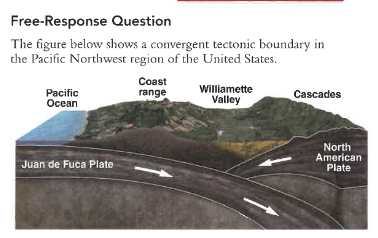
(a) identify the mountain range produced by this tectonic plate boundary.
the mountain range produced by this tectonic plate boundary is the cascades; this is correct because volcanic ranges that happen as a result of subduction (one plate sliding under another) typically form closer inland. also, you can sort of see the channel of magma that opened under the north american plate when the volcanoes were formed
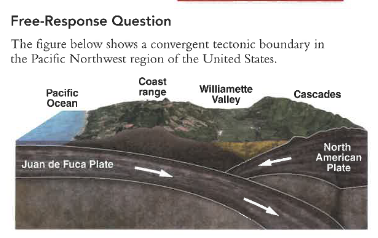
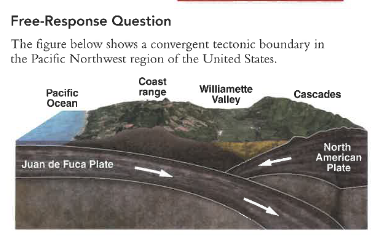
(b) describe the tectonic process occuring to the juan de fuca plate at this convergent boundary.
the tectonic process occuring to the juan de fuca plate at this convergent boundary is subduction; this is correct because subduction occurs when an oceanic plate (juan de fuca) meets with and goes under a continental plate (north american plate)
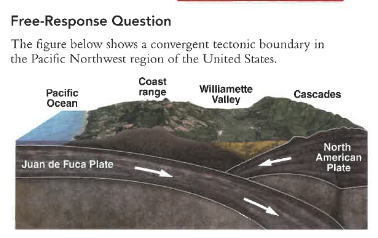
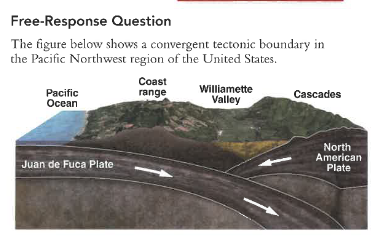
(c.) explain why volcanic mountains are formed at this type of boundary.
volcanic mountains are formed at this type of boundary because when a plate undergoes subduction at a convergent plate boundary, the oceanic plate is turned downward into the mantle, which melts the rock into magma, which then rises to the top of the crust to form volcanoes because the magma is less dense than the surrounding rock; this is correct because it explains the process of subduction at a convergent plate boundary and how that process forms a volcano/volcanic mountain ranges
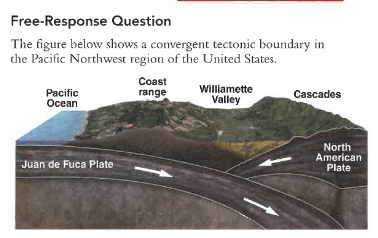
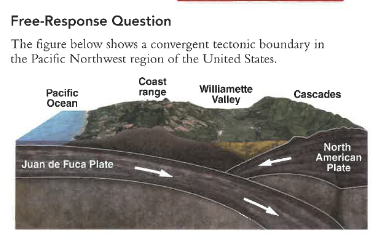
(d) describe an environmental problem that can occur as a result of a volcanic eruption at this plate boundary
an environmental problem that can occur as a result of volcanic eruption at this plate boundary is poorer air quality; this is correct because volcanoes often release gases like sulfur dioxide when they erupt, which can result in poorer air quality as it messes with the natural balance of oxygen, nitrogen, and carbon dioxide
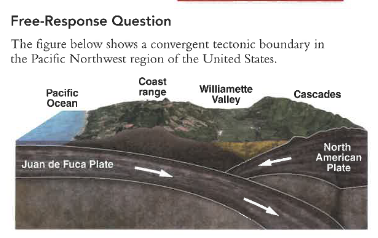
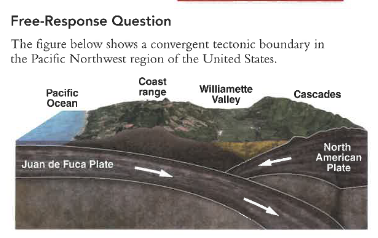
(e) the juan de fuca plate is moving toward the north american plane at an average of 11.8 feet per 100 years.
next slide because its a 3 part answer
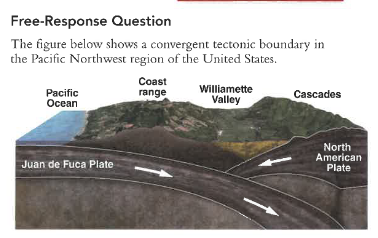
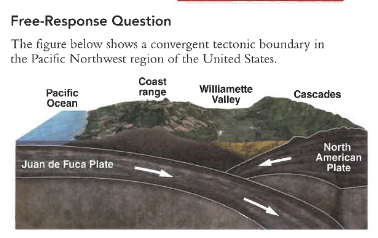
(e) (i) calculate the average rate of movement of the juan de fuca plate in millimeters per year (mm/year) if there are 30.5 centimeters in a foot (j.d.f. plate moves at a rate of 11.8 feet/100 years). show all work.
39.55 mm/year; this is correct based on the calculations in the image. we are told that the tectonic plate moves at a speed of 11.8 feet per year, which is the rate of movement, however, it is asking for different units (mm/year). so, we can start with (11.8 feet/100 years) and multiply that by (30.5 cm/1 foot) to convert feet to centimeters. then, we multiply that by (10 mm/1cm) to convert centimeters to millimeters. once we combine everything together, we get 3,599 mm/100 years, which simplifies to a rate of 35.99 mm/year, our final answer

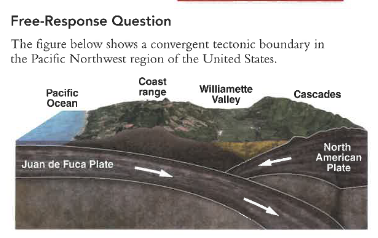
(e) (ii) at its fastest, the juan de fuca plate moves 13.8 feet per 100 years, or 42 mm/year. calculate the percent difference between the plate’s fastest rate and it’s average rate (35.99 mm/yr) from (i). show all work.
the fastest rate is 16.69% greater than the average rate; this is correct given the calculation shown in the image. the formula for percent difference is |(fastest - average) / (average)| x 100 = % difference. so, based on our answer from one and because they give us the fastest rate (42 mm/yr), we can plug that into our equation: |(42 - 35.99)/(35.99)| x 100 = 16.69% difference

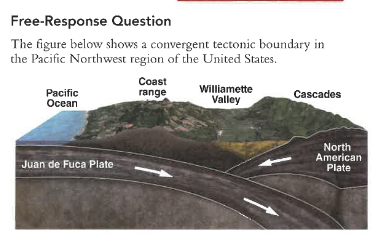
(e) (iii) calculate how many years it would take for the juan de fuca plate to travel 100 meters (based on average rate). show all work.
about 2,778.5 years; this is correct given the calculation in the image. we can determine this using this formula: distance/rate = time (years). because our rate is in millimeters (mm), we must first convert 100 meters into millimeters using this unit conversion: (100 meters)(1000 mm/1 meter) = 100,000 mm. then, we plug 100,000 mm for our distance and 35.99 as our rate into our distance/rate = time (years) equation→ 100,000 mm/35.99 (mm/yr) = about 2,778.5 years

module 20 frq
next slide
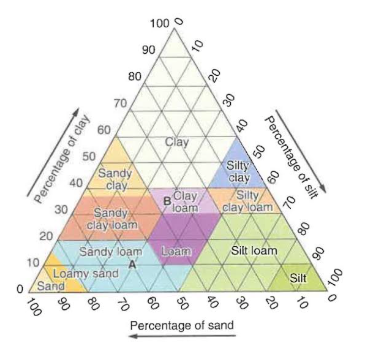
(a) identify the percentage of silt in sample A.
sample A has 30% of silt in its composition; this is correct according to the image→ if we follow the diagonal line representing a 30% silt composition, we eventually reach point a, which represents sample A

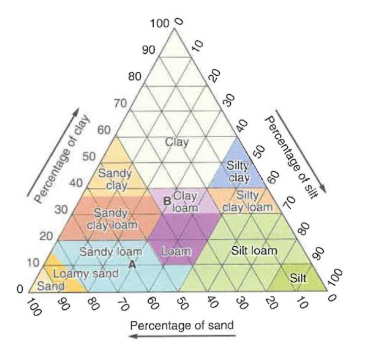
(b) describe which soil sample would be best for plants that prefer quick-draining soils.
soil sample A would be best for plants that prefer quick-draining soils because it contains a greater percentage of sand and a smaller percentage of clay than does sample B, meaning that sample A has a higher porosity and thus is a quicker-draining soil than sample B; this is correct because sand and silt have higher porosity (size of air space that allows for water/other things to pass through) than clay, and because sample A has more sand and sample B has more clay, sample A is a quicker-draining soil
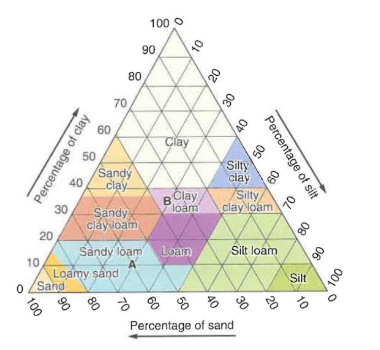
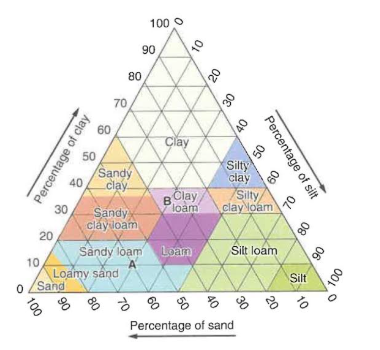
(c.) describe from which soil horizon the samples were most likely collected.
the samples were most likely collected from the A horizon, given the depth of 0.25 meters; this is correct because the O horizon extends only a few inches below the earth’s surface, whereas the A horizon extends usually until about 0.3-0.4 meters deep.
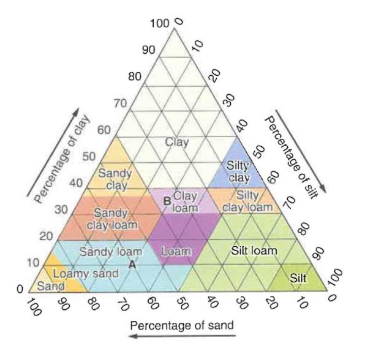

(d) explain how the water-holding capacity of soil can inform decisions about watering plants.
water holding capacity determines how much water the soil can hold against the force of gravity. this informs decisions about watering plants because higher water holding capacity means that watering is necessary less frequently, and lower water holding capacity means that watering is necessary more frequently; this is correct because soil that holds water for longer periods of time (longer WHC) won’t need to be watered as much, and visa versa
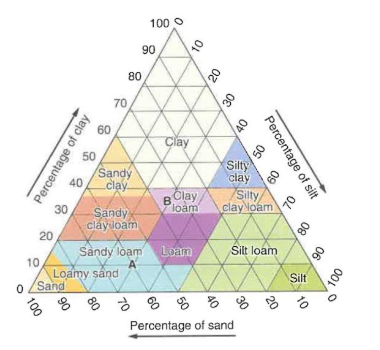
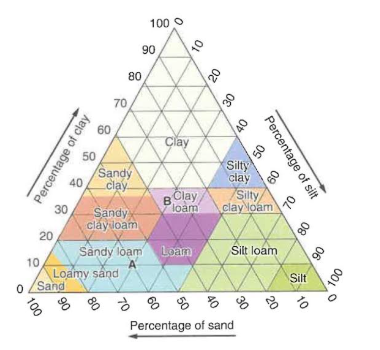
(e) a farmer decides that soil sample B would be the better choice of soil for planting crops. using the data in the soil triangle, justify whether you support or refute the farmer’s claim.
I support the farmers decision to use sample B for planting crops because it contains a balanced proportion of sand, silt, and clay, which is ideal for agriculture because it has good water retention, adequate drainage, and higher nutrient holding capacity than sand alone due to its moderate porosity; this is a correct answer based on the justification given above, but, as long as you justify your answer, pretty much any answer can work
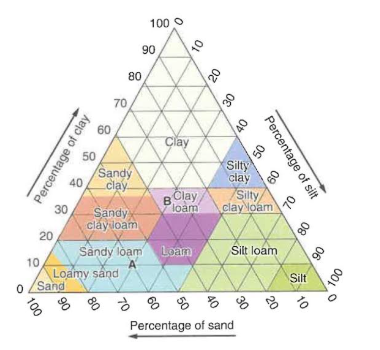
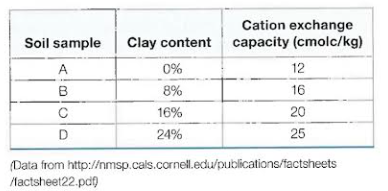
(f) a group of AP® environmental science students design an experiment to test the cation exchange capacity (CEC) of different soil particles. their results are shown in the table below:
questions on next slide

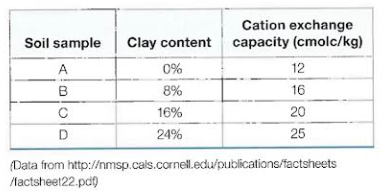
(f) (i) identify the independent variable for this experiment.
the independent variable is the clay content of the soil; this is correct because the cation exchange capacity is dependent on the clay content percentage of the soil, making clay content % the independent variable
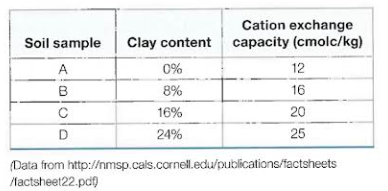
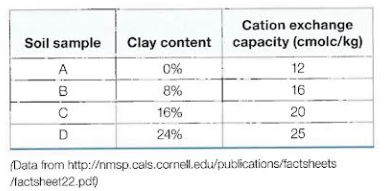
(f) (ii) identify a likely hypothesis for this experiment.
as the clay content of a soil increases, its cation exchange capacity will also increase; this is a correct hypothesis example because the table shows that as clay content increases, so does cation exchange capacity, making this a possible hypothesis that led the experiment
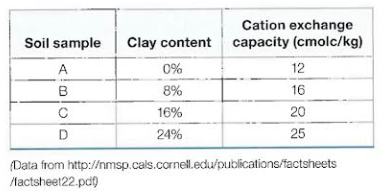
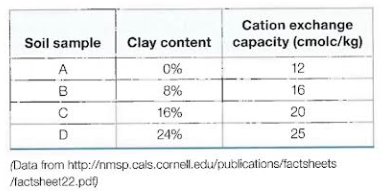
(f) (iii) identify the control for this experiment.
the control for this experiment is soil sample A, which has a clay content of 0%; this is correct because the ‘control’ individual or group is not manipulated. this would work in accordance with our hypothesis because if clay content increase is positively correlated with cation exchange capacity (CEC) increase, then experimenters can set a control of a soil type with a 0% clay content
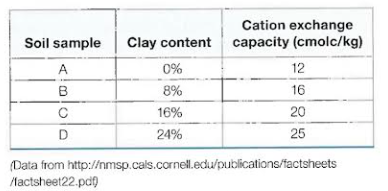
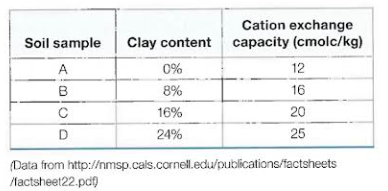
(f) (iv) describe a modification that could be made to the students’ experiment that could improve their results.
to improve the experiment’s results, the students could conduct multiple trials to enhance the reliability and validity of the experience; this is correct because if the students were to conduct multiple trials in the experience, it would enhance reliability (constancy of test results) and validity (extent to which results predict what they’re supposed to)
